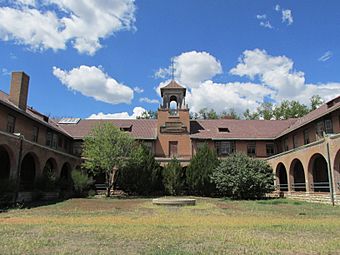Castañeda Hotel facts for kids
Quick facts for kids |
|
|
Castañeda Hotel
|
|
|
U.S. Historic district
Contributing property |
|

The hotel in 2013
|
|
| Location | 541 Railroad Ave., Las Vegas, New Mexico |
|---|---|
| Built | 1899 |
| Architect | Frederick Roehrig |
| Architectural style | Mission Revival |
| Part of | Railroad Avenue Historic District (Las Vegas, New Mexico) (ID79001551) |
The Castañeda Hotel is a historic railroad hotel in Las Vegas, New Mexico. It was built in 1898 and 1899 by the Atchison, Topeka and Santa Fe Railway. The Fred Harvey Company ran it until 1948. After being empty for many years, the hotel was fixed up and reopened in 2019. The Castañeda is an important building listed on the New Mexico State Register of Cultural Properties and the National Register of Historic Places. It is right next to the Las Vegas train station.
History of the Castañeda Hotel
In the 1890s, the Atchison, Topeka and Santa Fe Railway had a small hotel in Las Vegas. It was called the Depot Hotel. Passengers could eat there during train stops. In 1898, the railroad built a new, much bigger hotel. This was the Castañeda. The Fred Harvey Company managed it.
The Castañeda was the very first of many "Harvey hotels." These hotels were built along the Santa Fe train lines. Other famous Harvey hotels include the Alvarado in Albuquerque, New Mexico, and El Tovar at the Grand Canyon.
The hotel was designed by Frederick Roehrig. It officially opened on January 1, 1899. It was named after Pedro de Castañeda de Nájera. He wrote about an expedition into New Mexico in 1540. Building the hotel cost $110,000. Furnishings cost another $30,000.
In June 1899, the hotel hosted Theodore Roosevelt. He was the governor of New York at the time. It was the first reunion for his group, the Rough Riders. By the 1940s, the hotel started losing money. Train travel had a brief boost during World War II. But after that, the railroad closed the hotel in June 1948.
The local newspaper, the Las Vegas Optic, wrote about the closure:
The Castaneda has been a center of social activity for the community. Its walls have resounded the oratory of locals and visitors at civic, political and fraternal banquet sessions. Evening-gowned ladies have brushed elbows with smoke-darkened railroaders. Cowboys have perched at the counter alongside eastern dandies. Politicians and salesmen have shared the lobby. Life won't seem the same with the Castaneda closed.
For the next 70 years, the hotel was mostly empty. But it was saved from being torn down. Some rooms were used as apartments. The hotel bar stayed open. But most of the building was empty and getting old.
In 2014, Allan Affeldt bought the hotel. He had also restored the La Posada Hotel in Winslow, Arizona. Affeldt spent three years and $6 million fixing up the Castañeda. He also restored the nearby Plaza Hotel. The Castañeda Hotel reopened in 2019.
Hotel Architecture and Design
The Castañeda Hotel was designed by Pasadena architect Frederick Roehrig. It was the first building in New Mexico to use the Mission Revival style. It was also the first Mission-style Harvey hotel. This made it a model for other buildings the Santa Fe Railway built later.
The Castañeda is a two-story building shaped like a "U." It is made of brick. It has a central courtyard that faces the train tracks. A 500-foot (150 m) long covered walkway goes around the front and sides of the hotel. The two side wings have curved, Mission-style gables. There is also a tall bell tower above the main entrance.
Inside, the hotel has about 30,000 square feet (2,800 m2) of space. It also has a large attic and basements under the north and south wings. The south basement holds machines. The north basement was used for storage. When it first opened, the ground floor had a dining room with 108 seats. It also had a lunch counter with 50 seats and a newsstand. The second floor had 37 guest rooms.
Images for kids





